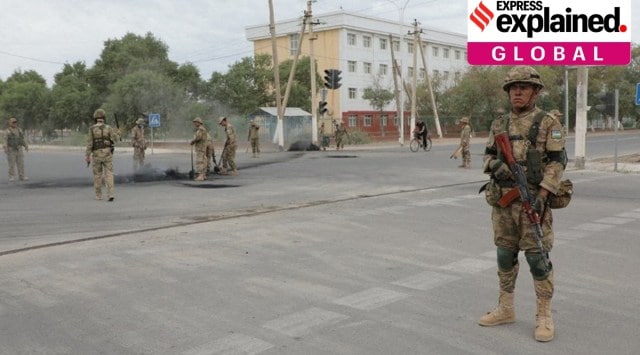Explained: Who are the Karakalpaks, residents of an unrest-hit Uzbekistan province?
Protests had broken out in response to the government’s plan to restrict the region’s long-held autonomy.
 Uzbek service members are seen in Nukus, capital of the northwestern Karakalpakstan region, Uzbekistan (KUN.UZ/Handout via REUTERS)
Uzbek service members are seen in Nukus, capital of the northwestern Karakalpakstan region, Uzbekistan (KUN.UZ/Handout via REUTERS) At least 18 people were killed and 243 wounded during last week’s government crackdown on protests in Uzbekistan’s autonomous province of Karakalpakstan. The protests had broken out in response to the government’s plan to restrict the region’s long-held autonomy.
On Friday, thousands took to the streets of the region’s capital, Nukus. In response, President Shavkat Mirziyoyev said on Saturday (July 2) that the government would abandon its plan to amend articles of the constitution relating to Karakalpakstan’s autonomy and its right to secede.
Mirziyoyev also declared a month-long state of emergency in the northwestern province.
Who are the Karakalpaks?
The name Karakalpakstan is derived from the Karakalpak people, an ethnic minority group of around 2 million. Karakalpak translates to ‘black hat’, referring to their traditional headgear.
The Karakalpaks consider themselves to be a distinct cultural group in Uzbekistan. Their Turkic language – Karakalpak – is closely related to Kazak and is one of the 7 languages of instruction in Uzbekistan’s public schools. Their separate language is a crucial aspect of their cultural identity.
In their genealogical narrative, the Karakalpaks claim to share a common point of origin with the neighbouring Kazakhs, Uzbeks and Turkmen, but believe that over time they diverged from the others. This narrative marks the Karakalpaks as culturally separate from their neighbouring groups, according to Reuel R Hanks, a scholar of Central Asia studies.
What is the region’s history?
The Karakalpak people settled around the Amu Darya (a river that feeds into the Aral Sea) in the 18th century. By 1873, they partly came under Russian rule and by 1920 were completely incorporated into the Soviet Union.
Their region, Karakalpakstan, was an autonomous area within the Russian Soviet Federative Socialist Republic (Russia during 1917-1922), before it was made a part of Uzbekistan as the Karakalpak Autonomous Socialist Republic (ASSR) in 1936.
When Uzbekistan declared its independence from the Soviet Union in August 1991, Karakalpak ASSR was re-established as the Republic of Karakalpakstan in December of the same year. Karakalpakstan was formally recognized as an autonomous republic in Uzbekistan’s constitution of 1992, and has the right to secede from on the basis of a nation-wide referendum.
Why triggered the recent protests?
Violent protests broke out in the impoverished Karakalpakstan after President Shavkat Mirziyoev, who has been in power since 2016, published a draft amendment to the Uzbek constitution on June 27, which removed the region’s right to secede Uzbekistan by a referendum.
Uzbek media quoted government officials who said that the amendments were approved by Karakalpakstan legislators, due to “numerous demands to define Karakalpakstan as an indivisible part of Uzbekistan,” according to broadcasting company Radio Free Europe/Radio Liberty.
How has the government reacted?
The Uzbekistan government stated that protestors had marched through the provincial capital of Nukus on Friday, and allegedly attacked the police and tried to take over government buildings.
With official death toll indicating that 18 people were killed and 243 injured during the violent unrest, President Shavkat Mirziyoyev dropped the plans to curtail Karakalpakstan’s right to secede.
However, the amendment which would allow presidential candidates to run for 7 year terms would continue to be in place, a change that would directly benefit Mirziyoyev who won his second 5 year term in October 2021, as reported by AFP.
Exiled opposition politician of the Berlik party, Pulat Ahunov, criticised the government’s use of lethal force and claimed that people were unable to obtain information due to the state of emergency imposed by the government. According to a BBC report, he said that he feared that the situation might escalate into an ethnic conflict between Uzbeks and the minority Karakalpaks.
Accusing the government of waging a “punitive operation”, Aman Sagidullayev, Norway-based leader of the pro-independence Alga Karakalpakstan party, told Reuters, “Karakalpaks are not Uzbeks…They have their own traditions, culture and law,”
Why do the Karakalpaks feel neglected?
An environmental crisis, and the health and economic troubles it brought in its wake, has made Karakalpakstan an impoverished region and invoked a sense of neglect among the Karakalpak people.
At one point in time, Karakalpakstan was one of the most fertile provinces in Uzbekistan, due to its location next to the Aral Sea.
However, the once 4th largest saline lake in the world, has been steadily shrinking and reducing the arable land in the province.
In the 1960s, the Soviet government began to divert water from the Amu Darya and Syr Darya rivers that feed into the sea, and used it to irrigate the nearby desert region for agriculture, mostly water-intensive cotton.
With the Aral Sea becoming increasingly drained of its water, the salt and mineral content began to drastically rise, making the water unfit to drink and killing off the fish in the lake. As a result, fishing industries and communities that relied on the sea collapsed.
It was accompanied by significant desertification of the region and Karakalpakstan, which primarily relies on agriculture and animal husbandry, has subsequently become Uzbekistan’s most impoverished region.
The Karakalpaks, who live south of the Aral Sea also face serious health problems, such as increased rates of throat cancer, kidney problems and the highest infant mortality rate in the world. This is because the fertilisers and pesticides that were used for cotton farming saturated the surrounding land and were carried across the region by wind blowing across the exposed seabed.
- 01
- 02
- 03
- 04
- 05






































